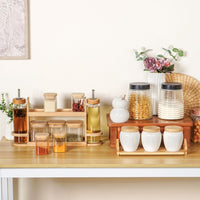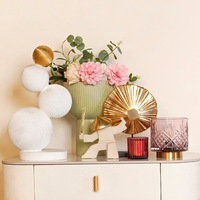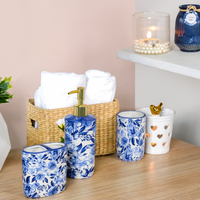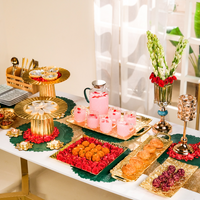Welcome to the enchanting realm of gardening, where your imaginations take a flight to sprout into lush realities with a touch of greenery. Whether you’re a beginner or a gardening genius - we are here to help you create the perfect green wonderland. We’ll unveil the secret weapons that can help turn your gardening dreams into a vibrant tapestry of fragrances and colours.
Get ready to embark on a fruitful journey and explore a wide selection of trusted gardening companions. From the mighty yet humble gardening trowel to help bring the tiny seeds to life to the artistic pruner to shape your green babies with the perfect precision and finesse - we’ve got everything! We’ll also explore how a pair of gloves can help you unleash your gardening superpowers and more.
Roll up your sleeves, pull up your socks, and discover your inner green thumb with us. Let your creative juices flow and get your hands dirty to watch your seeds of imagination shape up into stunning beauties of nature. As you sow, so shall you reap!
7 Essential Gardening Tools & Their Uses For Beginners
1. Bucket
The bucket is a necessary piece of equipment that will serve as your dependable buddy as you set out on this horticulture journey. Buckets are incredibly versatile in the world of gardening beyond their conventional usage.

Consider using buckets for more than just watering plants; they can also be used as portable planters that let you cultivate herbs, flowers, and even vegetables anywhere. They are ideal for constructing a temporary compost bin so that food waste can be recycled and turned into natural, organic manure to enrich the garden soil. Have no room for a garden? Create a vertical garden using buckets to make the most of your small space.
Additionally, buckets make weeding simple and can hold all of your gardening supplies, saving you from making numerous roundtrips. For gardeners of all skill levels, buckets are a game-changer for everything - from mixing soil to harvesting fruits. Unlock the true potential of this trusted gardening sidekick and put it to good use.

2. Gloves
Imagine yourself as a novice gardener happily caring for your plants, yet you wind up with dirty hands and a few bothersome scratches. Here comes your reliable ally, the gardening gloves! These unsung heroes are more than just for show; they protect your hands from thorns, splinters, and creepy crawlies so you may appreciate gardening's beauty without having to deal with the mess or pesky insect bites.

Get a good grip with gloves that provide improved traction on tools, which makes planting and trimming a lot easier. Concerned about exposure to chemicals? Fear not! Your hands are protected from harsh pesticides and fertilisers by a suitable pair of gloves. Utilise your gloves to protect your skin while you embrace the sensation of awe that comes with taking care of your green babies.
3. Trowel
Calling all green-thumbed newbies! You don't need to look any further than the mighty trowel if you're prepared to turn your patch of barren ground into a vivid green sanctuary. The impact of this little, palm-sized tool is enormous despite its diminutive appearance.

The trowel becomes your dependable companion as you begin your gardening journey, skilfully digging holes for plants and bulbs to ensure they have a comfortable place to thrive. Transplanting saplings becomes effortless thanks to their sharp edge, which easily slices through hard soil. Additionally, the trowel is ideal for weeding, keeping your garden healthy and beautiful.
A trowel in the hands of a novice unlocks countless opportunities. Therefore, this simple instrument is a necessity in your gardening arsenal, whether you're growing a veggie refuge or a blooming flower paradise. Embrace the power of the tiny trowel and watch your garden blossom into a work of art!
4. Spade
The spade might seem like a simple tool, but it can have an immeasurable impact on your green garden space. In fact, the spade is your greatest ally when it comes time to plant new saplings. It effortlessly slices through the earth to provide the ideal bed for your green babies, thanks to its sharp blade and durable construction. Spade can also be your best buddy if you want to divide the perennials!

Additionally, this gardening tool takes on challenging chores like edging and root removal, allowing the plants to grow and flourish. The spade evolves into an extension of your enthusiasm as you learn more about the art of gardening. It's a tool that turns the green sanctuary of your dreams into reality. So embrace the power of the spade and allow it to take your gardening goals to new heights!
5. Pruners
The secret to maintaining your plants in prime condition is pruning. Pruners are the garden's cosmetic surgeons, shaping wild plants, removing dead flowers, and pruning excessive branches. They promote healthy plant growth, enhancing the vitality of your cherished flora.

Pruners are the fundamental gardening tools for beginners to discover the art of plant care. Grooming plants becomes effortless thanks to their accuracy and simplicity of use. Soon enough, you'll be shaping your garden like a pro! So grab your pruners and become a gardening wizard.
6. Garden Fork
Imagine using a garden fork to care for your young trees, the tines sunk into the ground like a curious earthworm. A garden fork's main function is aeration, which involves loosening compacted soil to make room for plant roots to breathe. This important step enhances drainage, avoiding soggy roots. The garden fork also minimises weeding-related damage to fragile roots.

Its consistent strength also makes turning compost simple, providing your garden with organic food. Therefore, dear novice, accept the garden fork as your gardening companion. You'll discover a newfound love for gardening with it in your hands as you watch the beauties of nature come to life before your very eyes.
7. Shovel
The shovel stands out as a necessary tool for any beginning gardener among all gardening tools. The shovel's sturdy construction, which typically features a broad, flat blade and a long handle, makes it ideal for a variety of jobs. It is highly versatile and adaptable as a gardening tool. From digging planting holes and getting rid of weeds to transferring soil and mixing compost - the shovel is your one trusty companion.

Thanks to its ergonomic design, you can work effectively while putting less stress on your body. In addition, a shovel is an indispensable planter tool for preparing the soil, which is pivotal for healthy plant growth. By loosening and aerating the soil, it facilitates nutrient absorption and root development. Just remember to select the right shovel size and material for an enjoyable gardening experience.
How To Identify & Treat Common Gardening Issues
Identifying and treating common gardening issues is crucial to ensure the healthy growth of your plants. Here, we will explore some of the most frequent problems that gardeners face and provide practical tips on how to address them effectively.
1. Pests & Insects
Inspect your plants regularly to identify any signs of infestation by pests or insects. Common garden pests and insects include snails, slugs, aphids, caterpillars, and whiteflies.
Treatments
- Natural remedies: Use beneficial insects like lacewings or ladybugs to control other insects and pests organically in your garden.
- Homemade sprays: You can make homemade solutions of garlic, neem oil, or mild detergent, that work as excellent insect repellants.
- Commercial pesticides: In the case of large-scale infestations, choose eco-friendly commercial pesticides or insecticides that are suitable for gardening.
2. Plant Diseases
Keep an eye out for symptoms that may indicate plant diseases, such as wilting, discolouration, spots, mould, or any unusual growth on your plants.
Treatments
- Pruning: Remove the diseased part of the plant to prevent the infection from spreading to the healthy parts.
- Fungicides: In the case of fungal diseases, use fungicidal sprays. Read the instructions carefully before using fungicides.
-
Better air circulation: Proper spacing between plants can promote better air circulation and prevent diseases from spreading between plants.
3. Nutrient Deficiencies
Lack of nutrients will affect normal plant growth. Pay attention to signs like stunted growth, premature yellowing of leaves, or abnormal leaf patterns, which may indicate nutrient deficiencies.
Treatments
- Soil testing: Soil testing will help you determine which nutrients are lacking in your garden soil and adjust the level of essential soil nutrients accordingly.
- Organic fertilisers: You can use manure, compost, or other organic fertilisers to nourish your soil for better plant growth.
- Controlled-release fertilisers: Try using slow-release fertilisers for the constant supply of nutrients instead of using chemical fertilisers continuously.
4. Overwatering & Underwatering
Both overwatering and underwatering disrupt the normal growth of plants. Overwatering can cause wilting, yellowing of leaves, or rotting of roots, while underwatering may lead to stunted growth and drying of leaves.
Treatments
- Adjust watering schedule: The water requirement of each plant varies from one another. So, adjust your watering routine based on the needs of your plants.
- Improve irrigation & drainage: Make sure that your plant pots and flower beds have proper water drainage to avoid waterlogging in the garden soil.
- Mulching: Apply a layer of mulch over the garden soil around your plants to preserve moisture and prevent evaporation.
5. Weeds
Learn to distinguish between your desired garden plants and harmful weeds to avoid harming the plants while removing the weeds from your garden.
Treatments
- Pull off weeds: In the case of small infestations, you can simply pull off the weeds with your hands. But remember to pull them off by their roots and remove every part of their roots to avoid future infestations.
- Mulching: Apply a layer of organic mulch around your garden plants to suppress the growth of unwanted weeds.
- Herbicides: In extreme cases, use targeted herbicides to kill weeds, but be careful not to harm your garden plants.
5 Things To Decorate Your Home Garden
1. Cosy Sitting Corners
Create a comfy sitting nook in your backyard garden where you can spend a relaxing evening and enjoy the beauty of your garden in full bloom. Choose weather-resistant furniture, such as a wooden bench, a pair of patio chairs, or a bistro set, to create a cozy sitting nook in your home garden. Adorn the space with soft cushions, outdoor rugs, and fairy lights to create a warm and inviting atmosphere.
2. Magical Lighting
Install beautiful outdoor lighting to create an enchanting ambience in your garden during the night. For a captivating atmosphere, hang fairy lights from the trees or set up lanterns along the walkways which can make an evening walk in the garden truly therapeutic.
3. Green Garden Wall
If you have limited garden space, think about a vertical garden wall! Install wall-mounted planters or hanging baskets to grow varieties of vibrant flowers, succulents, or herbs. Vertical gardens not only make the most of small spaces but also add visual depth and dimension to your home garden.
4. Vegetable Patches
Create a functional and charming vegetable and herb garden. You’ll not only enjoy the experience of growing your own organic food but your entire backyard will also be filled with delightful aromas of fresh herbs and veggies
5. Enticing Garden Art
You can give your home garden a touch of flair by adding captivating garden art, including wind chimes, artistic sculptures, or handmade birdhouses. Choose art pieces that reflect your personal taste and style and blend them cohesively with the overall garden theme.
Conclusion
Remember, gardening is not just about nurturing plants; it's a journey that connects us with nature's wonders. We'd love to hear your gardening stories – the triumphs, the challenges, and the cherished moments. Share your experiences with us as we continue to grow together, inspired by the beauty of nature and the joy of cultivating life.
FAQs
What are the most important tools every gardener should have?
There are some must-have tools that can make your gardening journey much easier. Some of the most essential gardening tools include a sturdy pair of gloves to protect hands, a hand trowel for planting and weeding, a sharp pair of pruners for trimming plants, a watering can or hose for proper hydration, a rake for levelling soil and removing debris, and a hoe for cultivating and loosening soil. Additionally, a wheelbarrow helps transport heavy materials, while a sun hat and sunscreen protect from sun exposure. Investing in these fundamental tools will make gardening more efficient and enjoyable while promoting healthier plant growth.
What is a garden tool trowel used for?
A garden trowel is a handheld tool with a flat, pointed blade and is generally used for a variety of gardening and planting operations. Its primary use is for digging holes for seeds, bulbs, or saplings. The flat blade effectively scoops and transports soil while the pointed tip enables accurate penetration into the ground. Trowels are also used by gardeners to soften hard soil, transplant seedlings, and pull up weeds. Any gardener needs this equipment to accomplish delicate chores with accuracy and care due to its small size and simplicity of use.
What is a small gardening tool?
A handheld device made specifically for quick, small-scale gardening operations is referred to as a small gardening tool. It usually has a small size and is simple to handle. Hand trowels, hand pruners or secateurs, gardening shears, weeding knives, and hand cultivators are a few examples of small gardening equipment. For jobs like planting seeds, bulbs, or small plants, trimming and shaping plants, getting rid of weeds, and loosening soil in confined locations, these tools are perfect. They are indispensable for caring for delicate plants, small garden beds, and containers thanks to their portability and convenience, giving gardeners more control and precision in their work.
What are the names of the tools used in the garden?
Shovels, rakes, pruners or secateurs, garden forks, wheelbarrows, gardening gloves, and garden shears are a few of the tools frequently used in gardens. Every tool has a particular use, such as for digging, levelling soil, cultivating, pruning, planting, aerating, watering, carrying goods, and safeguarding hands. With the help of this crucial gardening tool, gardeners may effectively complete a variety of chores required for caring for and tending to plants and creating a lovely outdoor space, which is needed for keeping a well-kept and growing garden.
What is another name for a garden trowel?
A garden trowel is also referred to as a "hand trowel." This portable gardening tool is well known for having a flat, pointed blade that is perfect for precisely digging small holes in the ground and planting seeds, bulbs, or small plants. Gardeners can complete delicate jobs effectively using a hand trowel, thanks to its small size and ease of use. A versatile and essential tool for every gardener, the hand trowel is used for weeding, loosening compacted soil, and transplanting seedlings. The hand trowel proves to be an indispensable tool for any gardener, whether they are caring for a tiny garden bed, container plants, or completing difficult gardening jobs.
What is a planter tool?
A planter tool is a gardening tool made especially for planting saplings, seeds, or bulbs in the soil. It has a long and slender design with a pointed tip, making it easier to scoop up soil while digging holes for planting. Planter tools are mostly used in large-scale operations, such as sowing rows of crop seeds or making uniform holes for bedding plants. These tools are essential for farmers and gardeners alike because they save a lot of time and effort while ensuring the proper planting of seeds and saplings to optimise plant growth.
How do I identify my garden tools?
Take the following actions to identify your gardening tools:
- Look at the size and shape of the tool; shovels have broad, extended handles, whereas pruners have blades that resemble scissors.
- Look for labels or marks that identify the brand or model of the tool.
- Look up similar garden tools online or in catalogues to compare the tool's functionality.
- Look at the tool's handle's construction (wood or metal) and style (traditional or ergonomic).
- Consult with seasoned gardeners or seek advice at a nearby garden centre. You may confidently identify and categorize your gardening tools using a combination of these techniques, which will improve your gardening experiences.
What are the plant soil tools?
Tools for controlling and assessing soil conditions are crucial for promoting healthy plant growth. Typical plant soil tools include -
- Soil pH meter: Measures soil acidity or alkalinity, which is essential for understanding the availability of nutrients to plants.
- Soil moisture meter: Determines soil moisture levels, assisting in appropriate irrigation techniques.
- Soil thermometer: Measures soil temperature, which affects planting and germination choices.
- Soil testing kits: Provide a thorough examination of the nutrients in the soil, assisting with fertilizer application.
- Soil auger: It is useful in obtaining soil samples for examination and analysis.
- Soil penetrometer: Measures soil compaction, which is necessary for evaluating root growth.
By using these tools, farmers and gardeners may make well-informed choices that guarantee ideal soil conditions for strong plant growth.




























